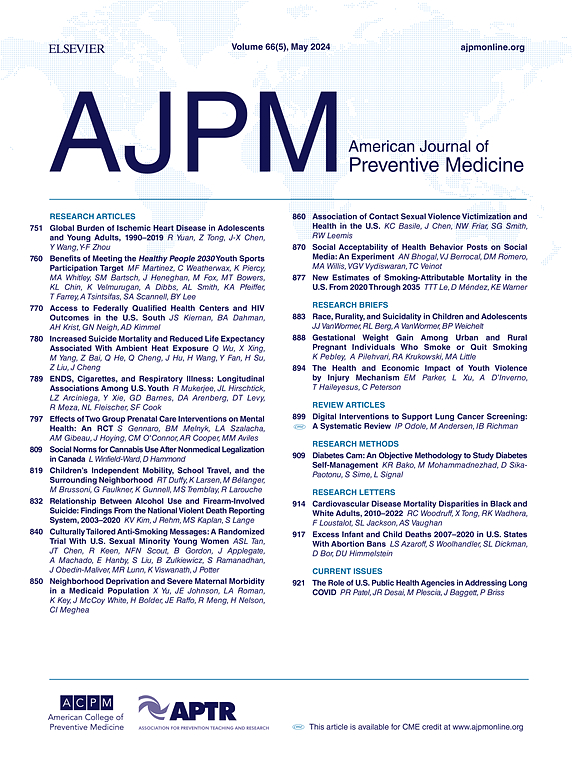Healthcare Utilization and Preventive Cardiovascular Health Screening Among Adults With Disabilities Amid COVID-19 Phases
IF 4.3
2区 医学
Q1 MEDICINE, GENERAL & INTERNAL
引用次数: 0
Abstract
Introduction
This study examines healthcare utilization and preventive cardiovascular health screening among U.S. adults in 2021–2023 compared with those in prepandemic Year 2019 by disability status.
Methods
This repeated cross-sectional analysis conducted in 2024 used data from National Health Interview Survey for years 2019–2023, including 150,198 adults. Disabilities were categorized as sensory, cognitive, physical, multiple, or none. Healthcare utilization measures (usual care source, wellness visits, and delayed/unmet care due to cost) and preventive screenings (blood pressure, cholesterol, glucose, flu-shot) were analyzed using descriptive methods and Poisson regression, reporting adjusted rate ratios with 95% CIs.
Results
During the COVID-19 pandemic, cardiovascular health screening rates decreased across all disability types except for sensory disability. Blood pressure screening for adults with cognitive disabilities dropped from 89% in 2019 to 83% in 2021, whereas blood glucose screening for those with multiple disabilities declined from 83.9% to 78.4%. Cholesterol screenings decreased across all disability types in 2021 but increased among adults with sensory disabilities in 2023 (adjusted rate ratio=1.07, 95% CI=1.03, 1.09). Notably, adults with cognitive (adjusted rate ratio=1.23, 95% CI=1.03, 1.43) and physical (adjusted rate ratio=1.13, 95% CI=1.01, 1.27) disabilities reported higher unmet medical needs due to cost than those without disabilities. Such differences persisted even after adjusting for pandemic-related socioeconomic changes (income, citizenship, employment, insurance).
Conclusions
U.S. adults with disabilities experienced increased delays in medical care and declines in cardiovascular screenings during the COVID-19 pandemic, highlighting ongoing disparities in healthcare utilization. These findings underscore the urgent need for public health initiatives to enhance preventive health screening uptake among adults with disabilities.
COVID-19阶段成人残疾患者的医疗保健利用和预防性心血管健康筛查
本研究调查了2021-2023年美国成年人的医疗保健利用和预防性心血管(CV)健康筛查,与2019年大流行前的残疾状况相比。方法:这项重复横断面分析于2024年进行,使用了2019年至2023年全国健康访谈调查的数据,包括150,198名成年人。残疾分为感觉残疾、认知残疾、身体残疾、多重残疾和无残疾。使用描述性方法和泊松回归分析医疗保健利用措施(常规护理来源、健康访问和因成本而延迟/未满足的护理)和预防性筛查(血压、胆固醇、葡萄糖、流感疫苗),报告调整率比(arr), ci为95%。结果:在COVID-19大流行期间,除感觉残疾外,所有残疾类型的CV健康筛查率均下降。患有认知障碍的成年人的血压筛查从2019年的89%下降到2021年的83%,而患有多种残疾的人的血糖筛查从83.9%下降到78.4%。2021年,所有残疾类型的胆固醇筛查都有所下降,但在2023年,感觉残疾的成年人胆固醇筛查有所增加(ARR 1.07, 95%CI: 1.03-1.09)。值得注意的是,与没有残疾的成年人相比,有认知残疾(ARR:1.23, 95%CI: 1.03-1.43)和身体残疾(ARR:1.13, 95%CI: 1.01-1.27)的成年人报告说,由于费用原因,未满足的医疗需求更高。即使在调整了与大流行相关的社会经济变化(收入、公民身份、就业、保险)之后,这种差异仍然存在。结论:在COVID-19大流行期间,美国成年残疾人在医疗保健方面的延误增加,心血管筛查减少,凸显了医疗保健利用方面的持续差距。这些发现强调了迫切需要采取公共卫生举措,以加强残疾成年人的预防性健康筛查。
本文章由计算机程序翻译,如有差异,请以英文原文为准。
求助全文
约1分钟内获得全文
求助全文
来源期刊

American Journal of Preventive Medicine
医学-公共卫生、环境卫生与职业卫生
CiteScore
8.60
自引率
1.80%
发文量
395
审稿时长
32 days
期刊介绍:
The American Journal of Preventive Medicine is the official journal of the American College of Preventive Medicine and the Association for Prevention Teaching and Research. It publishes articles in the areas of prevention research, teaching, practice and policy. Original research is published on interventions aimed at the prevention of chronic and acute disease and the promotion of individual and community health.
Of particular emphasis are papers that address the primary and secondary prevention of important clinical, behavioral and public health issues such as injury and violence, infectious disease, women''s health, smoking, sedentary behaviors and physical activity, nutrition, diabetes, obesity, and substance use disorders. Papers also address educational initiatives aimed at improving the ability of health professionals to provide effective clinical prevention and public health services. Papers on health services research pertinent to prevention and public health are also published. The journal also publishes official policy statements from the two co-sponsoring organizations, review articles, media reviews, and editorials. Finally, the journal periodically publishes supplements and special theme issues devoted to areas of current interest to the prevention community.
 求助内容:
求助内容: 应助结果提醒方式:
应助结果提醒方式:


